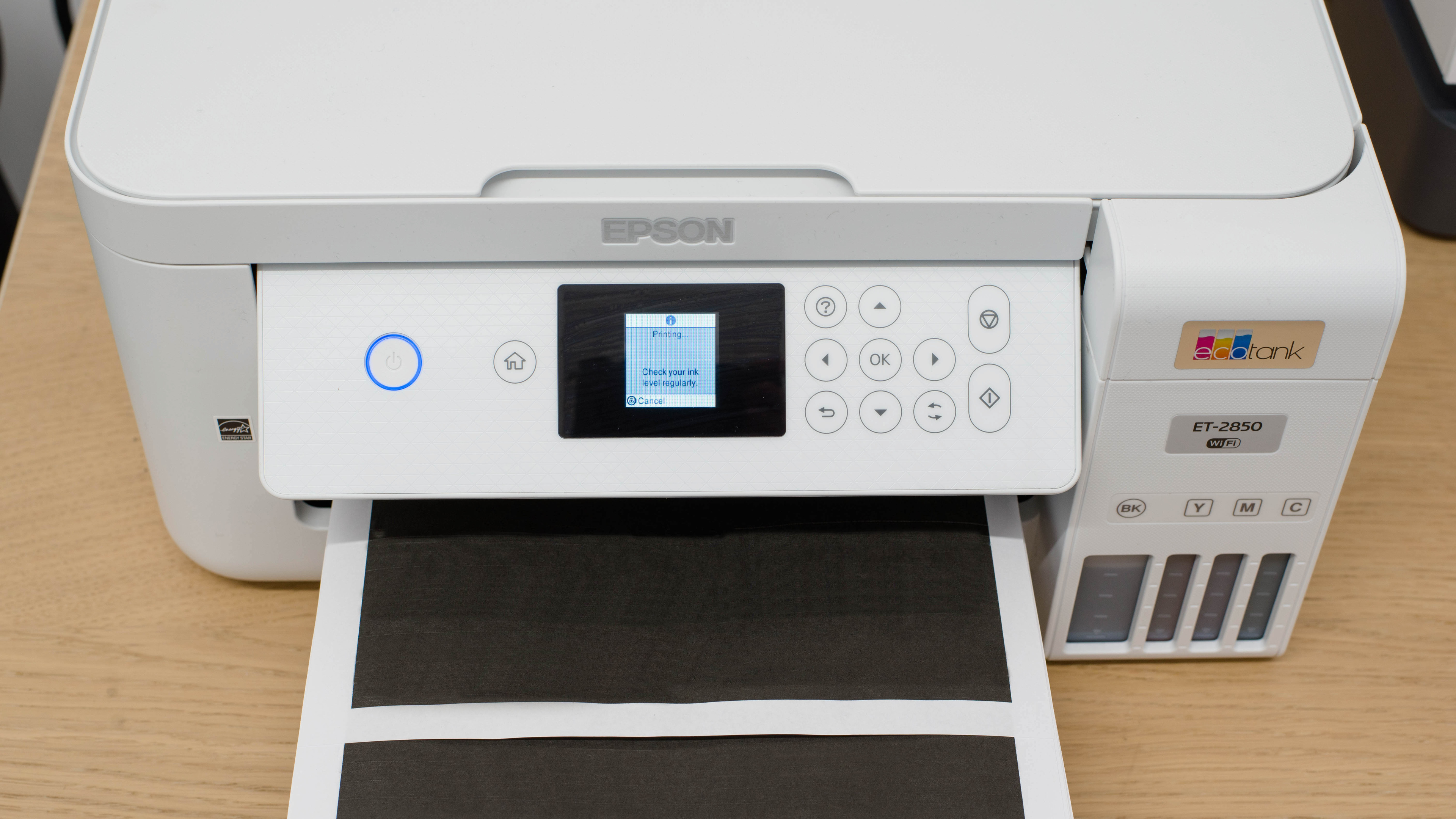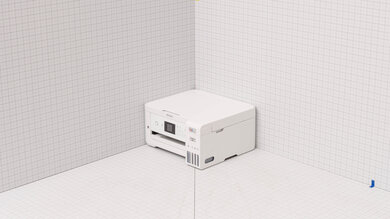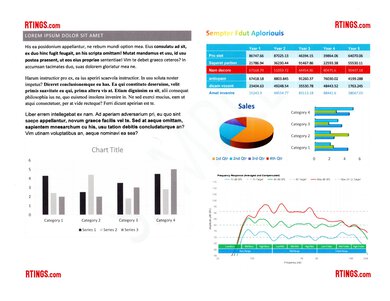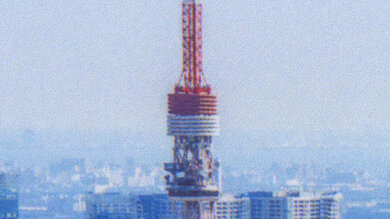The Epson EcoTank ET-2850 is an all-in-one printer designed for small or home offices. It replaces the now-discontinued Epson EcoTank ET-2760 and is similar in design and performance, with one difference: there's no SD card slot like its predecessor. It has USB and Wi-Fi connectivity, an 8.5x11 flatbed scanner, and a 100-sheet input tray. It supports duplex printing but not duplex scanning since it lacks an automatic feeder.
Our Verdict
The Epson EcoTank ET-2850 is very good for family use. It can print thousands of pages before you need to refill its tanks, and replacement ink is cheap. There's a flatbed scanner to scan old pictures, drawings, or pages from a recipe book. However, while it prints very sharp, detailed photos, color accuracy is poor, so most images won't necessarily come out looking like the original.
- Incredibly high page yields.
- Very low cost-per-print.
- Great photo printing quality.
- Bad color accuracy.
- Slow printing speed.
The Epson ET-2850 is good for small or home offices. Its supertank system ensures that you can print hundreds of pages a week without buying new ink bottles, which are pretty cheap given the number of pages you can print from a refill. Unfortunately, it doesn't have an automatic document feeder, so it isn't the best for high-volume scanning. Also, it prints slowly, which isn't ideal if you're on a time crunch.
- Incredibly high page yields.
- Very low cost-per-print.
- Good document printing quality.
- Slow printing speed.
- No automatic document feeder.
The Epson EcoTank ET-2850 is great for students. You can print hundreds of pages a week and still have enough ink to last you months, which is great if you're handing in lots of printed essays and reports. It has a flatbed scanner, so you can easily scan textbook pages or handwritten notes. You can print wirelessly by either connecting to the printer or using the mobile app. Unfortunately, it's slow at printing, so you'll need to be very patient while it prints out your long documents.
- Incredibly high page yields.
- Very low cost-per-print.
- Supports wireless printing.
- Good document printing quality.
- Slow printing speed.
The Epson ET-2850 is good for black-and-white printing. You can print thousands of pages before the black ink starts running low, which is great if you print in high volumes for your small business or schoolwork. The high page yield, paired with the inexpensive ink bottle cost, results in a very low cost-per-print. Document quality is also pretty sharp. Unfortunately, its printing speed is slow, which is annoying if you often print long, multi-page reports.
- Incredibly high page yields.
- Very low cost-per-print.
- Good document printing quality.
- Slow printing speed.
- No automatic document feeder.
The Epson EcoTank ET-2850 is good for photos. While it has a wide color gamut and prints nicely detailed photos, its color accuracy is poor, with some images having a decidedly bluish tone and many shades being reproduced inaccurately. On the bright side, its cost-per-print is very low because the ink tank yields a large number of prints, and replacement ink is cheap.
- Incredibly high page yields.
- Very low cost-per-print.
- Great photo printing quality.
- Bad color accuracy.
- Can't print 2x3 photos.
- Incredibly high page yields.
- Very low cost-per-print.
- Incredibly high page yields.
- Very low cost-per-print.
- Incredibly high page yields.
- Very low cost-per-print.
- Incredibly high page yields.
- Very low cost-per-print.
- Incredibly high page yields.
- Very low cost-per-print.
Performance Usages
Changelog
-
Updated Dec 12, 2024:
We've added mention of the Epson Expression Photo XP-8800 as an alternative with much faster photo printing in the Printing Speed section.
- Updated May 09, 2024: Added mention of the Canon MegaTank MAXIFY GX2020/GX1020 as an alternative with an ADF in the Scanner Features section.
- Updated Mar 13, 2024: We've updated the review for clarity and conciseness.
- Updated Mar 22, 2023: We've updated the text in the review to account for the new or updated tests in Printer Test Bench 1.1 and Printer Test Bench 1.2.
Check Price
Differences Between Sizes And Variants
There are two color variants of the Epson EcoTank ET-2850: 'Black' and 'White.' We tested the 'White' variant. There's also an Epson EcoTank ET-2850 Special Edition variant, which is a Costco exclusive that comes with an additional bottle of black ink.
See our unit's label here.
Popular Printer Comparisons
The Epson EcoTank ET-2850 is a good inkjet printer compared to other models in its class. It stands out for its wide color range, high page yields, and low cost-per-print. However, its slow print speeds might be a dealbreaker for some. Also, although it produces good-quality documents, you can find lower-end models that perform better.
See our recommendations for the best home printers, the best cheap ink printers, and the best all-in-one printers.
The Canon PIXMA G6020 and the Epson EcoTank ET-2850 are both supertank printers. If you print monochrome documents most often, the Epson is a better choice. It prints thousands more black pages than the Canon, so you won't have to refill the tank as often. On the other hand, the Canon can print more color pages. This, paired with its lower ink bottle cost, gives it a lower cost-per-print for color printing and photos. It's also much faster at printing photos.
The Epson EcoTank ET-3850 is the step-up model of the Epson EcoTank ET-2850. They're very similar, but the ET-3850 has more helpful features for a small office, like a larger display, an automatic document feeder, and an Ethernet port. It also has higher page yields and faster printing speed.
While the HP Smart Tank 7301 [6001, 7001] and Epson EcoTank ET-2850 are supertank printers with refillable tanks, the HP is more versatile and better suited for most users. The HP is more feature-rich with an ADF and Ethernet connectivity; it performs better overall with much faster print speeds, almost twice the color print yield, and produces nicer color and black documents. By contrast, the scan quality is better on the Epson, but you have to scan one page at a time since it only has a flatbed.
The Epson EcoTank ET-2980 is the successor to the Epson EcoTank ET-2850. The new model is an improvement in many ways. It offers better black-and-white printing quality, it's noticeably quicker, and it delivers better color accuracy out of the box. Other than that, both printers are similar, notably offering amazing cost-per-print.
Test Results

The Epson EcoTank ET-2850's body is made of cheap-feeling plastic, but it still feels somewhat sturdy. The power cord is removable, making it easy to replace if damaged, and there's a dampener to prevent the flatbed scanner from slamming down. The ink tanks are easy to reach, but you need to lift the flatbed to open the ink tank cover. It's different from the Epson EcoTank ET-2800/ET-2803, which lets you remove the ink tank cover without moving any other parts out of the way.
Like all inkjet printers, the printheads can clog if you don't print for a while. If you experience print quality issues, there are a few built-in maintenance functions that can help resolve them, like printhead cleaning, printhead alignment, printhead nozzle check, power cleaning, and paper guide cleaning. It's easy to reach the ink tanks for refills; you just need to lift the scanner first to open the ink tank cover. Refilling the tanks is straightforward since the ink bottle have keyed nozzles that only fit with its corresponding tank, so you won't need to worry about accidentally refilling the wrong tank. The process can be messy, but at least you don't need to do it often, thanks to its incredibly high page yields. Note that once you refill the tanks, you need to reset the ink level counter each time since the printer can't measure exactly how much ink you have left. The sheet rollers are accessible by removing a panel at the back or by lifting the flatbed scanner. The paper tray can only hold 100 pages, so you have to add paper if you print many long documents.
After sitting unused for nearly two months, the magenta and cyan printheads were clogged. It took four printhead cleanings in a row and letting the printer rest for 12 hours before the printheads worked as intended. That said, you won't experience this amount of clogging if you use your printer regularly.
See the user guide here.
This printer yields an incredible number of pages thanks to its supertank system. There's no ink level sensor to precisely measure the remaining ink. Instead, the printer monitors ink usage internally to estimate when the ink levels run low, meaning you'll have to keep an eye on the ink levels to avoid completely emptying the tank, as doing so could introduce air bubbles into the print tubes and damage the printheads. You'll have to manually reset the ink levels when you refill the tanks. The printer will continue printing even when it's out of ink. While there's no formal warning for low ink levels, you will receive this reminder once ink levels drop roughly below a quarter full.
The OCR (optical character recognition) feature is software-based, meaning you need to install the Epson Scan 2 software to use it, and you can only initiate an OCR scan from your computer. If you need an automatic document feeder, check out the Epson EcoTank ET-3850 or the Canon MegaTank MAXIFY GX2020/GX1020.
The cost-per-print is very low, thanks to this printer's high page yield and inexpensive ink bottle refills.
The photo printing speed is particularly slow compared to most inkjet models. If you want a printer that can print photos much faster, check out the Epson Expression Photo XP-8800.
This printer can print on A5 paper, but you need to set a custom size to do so. You can set custom sizes with a width of 3.5" to 8.5" and a length of 5" to 47.24".
The Epson ET-2850 has bad color accuracy. While this isn't an issue when adding color to a report or assignment, it is if you print photos regularly. Printed images are colorful, but most shades look drastically different from how they appear in the original image, especially browns, greens, and blues.
The Epson ET-2850 supports borderless printing, but there might be a slight loss in print quality.
The Epson Smart Panel app is feature-rich. It lets you print, scan, copy, check ink levels, and start a printhead cleaning. Some extra features include Access to Class, which lets you print assignments and documents from Google Classroom, and the Creative Print and Epson Gallery website lets you access artistic prints or printing on different media formats. A Guest Connection feature creates a QR code so your friends can easily connect to the printer. Microsoft Office and text files don't appear properly on the iOS version of the app, as the app alters the formatting, so you'll have to print them in whichever app you use to view those files.
You don't need to install drivers on macOS and Chrome OS devices, but you do on Windows devices, which you can get here. While there's no printing app, there's a maintenance tab in the Printing Preferences that lets you access printhead cleanings.


















